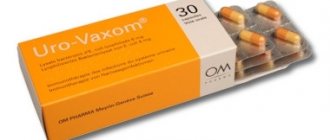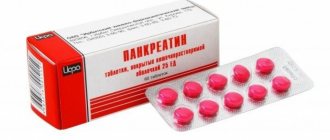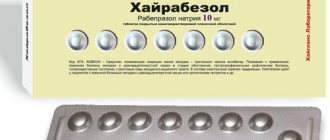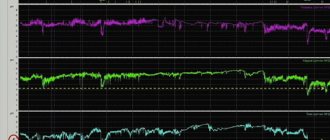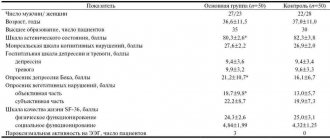Composition per 1 tablet:
Active substance:
Pancreatin - 100 mg The amount of pancreatin is indicated for a substance with an amylolytic activity of at least 1700 FIP units; lipolytic activity of at least 3000 FIP units; total proteolytic activity of at least 130 FIP units.
Excipients:
calcium stearate - 3.2 mg, potato starch - 7.4 mg, croscarmellose sodium - 1.2 mg, lactose monohydrate - to obtain an uncoated tablet weighing 320 mg
Excipients of the coating to obtain a tablet with a coating weighing 335 mg: titanium dioxide - 0.933 mg, azorubine dye (acid red dye 2C) - 0.025 mg, methacrylic acid and ethyl acrylate copolymer (1:1) - 6.948 mg, macrogol 4000 - 1.044 mg, talc - 4.184 mg, povidone - 1.866 mg.
Side effects
Therapy with Pancreatin extremely rarely leads to negative effects. In most cases, allergic reactions occur as side effects. Their manifestation is possible with individual hypersensitivity to the components of the medication.
With prolonged use of large doses of Pancreatin, in some cases hyperuricosuria develops. With this disease, uric acid urates accumulate and stones form.
It is extremely rare that in patients with cystic fibrosis, when using high doses, narrowing is observed in the ileocecal region and at the beginning of the colon.
Side effects from digestion are extremely rare:
- Pain in the epigastric region
- Diarrhea
- Nausea
- Constipation
- Intestinal obstruction
When using increased doses of Pancreatin in patients with cystic fibrosis, increased amounts of uric acid may be excreted in the urine. To prevent the formation of stones, in this group of patients it is necessary to regularly monitor the concentration of uric acid in urine.
Description:
Tablets coated with a pink or dark pink color interspersed with a specific odor, biconvex in shape, two layers visible on the cross section.
Pharmacotherapeutic group:
digestive enzyme agent.
ATX code
: A09AA02.
Pharmaceutical action
Pancreatin compensates for the insufficiency of the exocrine function of the pancreas and has proteolytic, amylolytic and lipolytic effects.
The enzymes included in pancreatin (lipase, alpha-amylase, trypsin, chymotrypsin) help break down proteins into amino acids, fats into glycerol and fatty acids, starch into dextrins and monosaccharides.
Improves the functional state of the gastrointestinal tract, normalizes digestion processes.
Trypsin inhibits stimulated pancreatic secretion and has an analgesic effect.
Pancreatic enzymes are released from the dosage form in the alkaline environment of the small intestine, since they are protected from the action of gastric juice by the membrane.
The maximum enzymatic activity of the drug is observed 30-45 minutes after oral administration.
What are Pancreatin tablets for?
The instructions describe the conditions and diseases for which you can take the drug:
- exocrine insufficiency of the intestine, liver, stomach, gall bladder;
- late pancreatitis that appeared after transplantation;
- problems with the gastrointestinal tract caused by prolonged immobilization of the patient;
- chronic diseases of the liver and biliary tract;
- feeling of fullness in the stomach;
- excessive accumulation of gases in the stomach;
- stabilization of the stomach in a healthy person, if it has been disrupted as a result of eating unhealthy and too fatty foods, overeating, a passive lifestyle or pregnancy;
- before performing an ultrasound of the digestive system.
Indications for use
Replacement therapy for exocrine pancreatic insufficiency: chronic pancreatitis, pancreatectomy, condition after irradiation, dyspepsia, Roemheld syndrome (gastrocardiac syndrome), cystic fibrosis; flatulence, diarrhea of non-infectious origin.
Impaired digestion of food (condition after resection of the stomach and small intestine); to improve food digestion in people with normal gastrointestinal function in case of errors in nutrition (eating fatty foods, large amounts of food, irregular meals) and in cases of chewing dysfunction, sedentary lifestyle, prolonged immobilization.
Preparation for X-ray examination and ultrasound of the abdominal organs.
Pancreatin
Pancreatin
(lat.
pancreatin
) - a medicinal product from the pancreas of pigs and cattle, replenishing the deficiency of digestive pancreatic enzymes. Pancreatin is the international nonproprietary name (INN) of the drug. According to the pharmacological index, it belongs to the group “Enzymes and antienzymes”. According to ATC - to the group “Drugs that promote digestion (including enzyme preparations)” and has code A09AA02.
The main function of pancreatin is to replenish pancreatic enzymes. Contains enzymes that play a critical role in the digestion process in the small intestine: lipase, alpha-amylase, trypsin, chymotrypsin and others. Without these enzymes, the final breakdown of proteins (the digestion of which began in the stomach) and the absorption of fats and starch are impossible. The enzymes that make up pancreatin, if they enter the stomach, are destroyed under the influence of hydrochloric acid and pepsin. In the human body, these enzymes enter along with pancreatic juice through the pancreatic duct, which opens into the duodenum at the papilla of Vater. When taking pancreatin orally, it is important to ensure the delivery of these enzymes to the small intestine without their contact with the aggressive environment of the stomach.
Trypsin in the proximal small intestine inhibits pancreatic secretion, causing the analgesic effect of pancreatin.
Dosage forms
.
Pancreatin is found in medications in various forms. These are either drugs containing only pancreatin as an active substance (mezim forte and others), or containing pancreatin in combination with other active substances. Medicines with the active substance hemicellulase + bile components + pancreatin
(festal and others) are widely used. To avoid the destruction of enzymes in the stomach, drugs are made in the form of tablets or dragees coated with a pH-sensitive coating. This coating does not dissolve in the acidic environment of the stomach and thus protects the enzymes contained in the core of the pill or tablet from destruction, which are released only in the duodenum.
In recent years, a new form of pancreatin-containing drugs (Creon and others) has been developed, in which digestive pancreatic enzymes are located in the cores of microspheres having a diameter of 1–1.2 mm. In turn, the microspheres are placed in capsules, which dissolve when they enter the stomach, and the microspheres are mixed with the gastric contents. A diameter of up to 1.2 mm allows the microspheres to pass into the duodenum without falling behind the bulk of the chyme. The pH-sensitive shell of the microspheres protects the enzyme from destruction in the acidic environment of the stomach, but in the duodenum at an acidity of about 5.5 pH, the shell of the microspheres dissolves and the enzymes begin their action.
Side effects.
Symptoms of intestinal obstruction: formation of strictures in the ileocecal region and ascending colon. Allergic reactions of immediate type in cystic fibrosis, especially in children.
Interaction.
Reduces iron absorption, especially with prolonged use.
The FDA Fetal Risk Category for pancreatin therapy in pregnant women
is C (animal studies have shown adverse effects of the drug on the fetus and there have been no adequate studies in pregnant women, but the potential benefits associated with the use of this drug in pregnant women may justify its use despite existing risk).
It is unknown whether pancreatin passes into human milk, so caution is required when using pancreatin in breastfeeding mothers.
.
Pancreatin is an over-the-counter product.
Trade names of drugs containing pancreatin
It is the main active substance that have or have registration in Russia
: Vestal, Gastenorm Forte, Gastenorm Fort 1000, Creon, Creon 10,000, Creon 25000, Creon 40000, Mezim 20,000, Mezim Forta 10,000, Mikrazim, Pangrol 10000, Pangrol 25000, Pangrool 25000, PanziCam, Panzym forte, Panzinorm forte-N, Panzinorm 10,000, Panzinorm forte 20,000, Pancreazym, Pancrealipase 8000, Kirschner's Pancreaal, Pancreatin concentrate, Pancreatin-LekT, Pancreatin, Pancreatin tablets (soluble in the intestines), Pancrelipase, Pankrenorm, Pancitrate *, Penzital, Uni-Festal, Festal N, Enzistal-P, Ermital.
*By letter of May 22, 2015, the Russian Ministry of Health canceled the registration of Pancitrate.
Trade names of drugs with the active substance hemicellulase + bile components + pancreatin
: Biofestal, Digestal, Digestal forte, Normoenzyme, Normoenzyme forte, Panolez, Ferestal, Festal, Enzistal.
Medicine with the active ingredient dimethicone + pancreatin
: Pankreoflat.
Medicine with the active ingredient
pancreatin + rice fungus extract
: Combicin.
In the USA, the following branded drugs with the only active ingredient pancreatin are approved for use: Hi-Vegi-Lip, Pancreatin 4X, Donnazyme, Digipepsin.
Pancreatin is included in some dietary supplements, for example, Biozyme.
By Order of the Government of the Russian Federation of December 30, 2009 No. 2135-r, pancreatin (capsules; film-coated tablets; enteric-coated tablets) is included in the List of vital and essential medicines.
Publications for healthcare professionals addressing the use of pancreatin in the treatment of diseases of the digestive system:
- Belmer S.V., Gasilina T.V. Digestive pancreatic insufficiency in children. Differentiated approach // Gastro News Line. – 2008. – No. 3. – p. 7–11.
- Sablin O.A., Butenko E.V. Enzyme preparations in gastroenterology // Consilium-Medicum. – 2004. – Volume 6. – No. 1. Gastroenterology.
- Gubergrits N.B., Vasilenko I.V., Agibalov O.M., Fomenko P.G., Golubova O.O., Achkasova A.A. Rational therapy for gastroesophageal reflux in chronic pancreatitis // Bulletin of the Pancreatology Club. 2009. No. 3. P. 70-86.
- Serebrova S.Yu. Prospects for the use of enzyme preparations in gastroenterology // Diseases of the digestive organs. – 2006. – volume 8. – No. 1. – p. 23–27.
- Kostyukevich O.I. Digestive insufficiency and its correction from the position of a gastroenterologist // Russian Medical Journal. Diseases of the digestive system. – 2008. – Volume 10. – No. 1. – p. 10–14.
On the website GastroScan.ru in the “Literature” section there is a subsection “Enzyme preparations”, containing publications on the use of enzyme preparations.
Video for medical university students
Frame “Pancreatin” from a video lecture for 3rd year students of the Faculty of Medicine of PSPbSMU named after. acad. I.P. Pavlova: Melnikov K.N. Drugs affecting the gastrointestinal tract
On the website in the “Video” section there is a subsection for patients “Popular Gastroenterology” and subsections “For Doctors” and “For Medical Students and Residents”, containing video recordings of reports, lectures, webinars in various areas of gastroenterology for healthcare professionals and medical students.
Pankeratin has contraindications and application features; consultation with a specialist is necessary. Back to section
Side effects
Allergic reactions. In some cases - diarrhea, constipation, discomfort in the stomach, nausea (the cause-and-effect relationship between the development of these reactions and the effect of pancreatin has not been established, since these phenomena refer to symptoms of exocrine pancreatic insufficiency). With prolonged use in high doses, perianal irritation and irritation of the oral mucosa may occur. Patients with cystic fibrosis may develop strictures in the ileocecal region and in the ascending colon.
Contraindications and adverse reactions
Like other medications, Pancreatin has several contraindications for use. These include:
- people with acute and aggravated chronic pancreatitis;
- excessive sensitivity to the constituent substances of the drug;
- intestinal obstruction;
- acute hepatitis.
In very rare cases, the drug can provoke the appearance of adverse reactions, which manifest themselves in the form of allergies to the constituent ingredients.
Long-term use of the drug at an increased dose can provoke hyperuricosuria.
It is extremely rare for the digestive system to experience problems associated with excessive excretion of uric acid in the urine (especially when the dosage is increased).
There may be cases of drug overdose, which is manifested by high levels of uric acid in the urine or blood.
special instructions
The safety of using pancreatin during pregnancy has not been sufficiently studied. Use is possible in cases where the expected benefit to the mother outweighs the potential risk to the fetus.
In cystic fibrosis, the use of pancreatin in high doses is not recommended due to the increased risk of strictures (fibrotic colonopathy). The dose should be adequate to the amount of enzymes necessary for the absorption of fats, taking into account the quality and quantity of food consumed.
With long-term use, iron supplements are prescribed simultaneously.
Pancreatin-Belmed tablets po enteric-soluble 25 units No. 10x5
Name
Pancreatin-Belmed tablet coated. k/r vol. 25 units per contact. cell pack №10x5
Description
Film-coated tablets, yellow to yellow-brown in color, with a biconvex surface. Unevenness and inclusions are allowed on the surface. When breaking the tablet, a specific smell is felt. The cross section shows two layers.
Main active ingredient
Pancreatin
Release form
Pills
Dosage
25 units
pharmachologic effect
Digestive enzyme agent. The pancreatic enzymes included in the composition (lipase, alpha-amylase, trypsin, chymotrypsin) promote the breakdown of proteins into amino acids, fats into glycerol and fatty acids, starch into dextrins and monosaccharides, improve the functional state of the gastrointestinal tract, and normalize digestive processes. Trypsin suppresses stimulated pancreatic secretion, producing an analgesic effect. The maximum enzymatic activity of the drug is observed 30-45 minutes after oral administration.
Indications for use
Disorders of the exocrine function of the pancreas (chronic pancreatitis, pancreatectomy), achylia. Preparation for X-ray examination and ultrasound of the abdominal organs.
Directions for use and doses
The drug is taken orally 3-6 times a day, during meals, without chewing and with plenty of liquid (water, fruit juices). The dose is set individually, depending on the age and severity of the digestive disorder. Adults and children over 14 years of age: the usual single dose is 50-100 units (2-4 tablets); the daily dose is 200-400 units (8-16 tablets). The average single dose for children 6-7 years old is 3 units (1 tablet), 8-9 years old – 25-50 units (1-2 tablets), 10-14 years old – 50 units (2 tablets). The duration of treatment can vary from several days (for indigestion, dietary errors) to several months and even years (if constant replacement therapy is necessary).
Use during pregnancy and lactation
The use of the drug during pregnancy and lactation is possible only if the expected benefit to the mother outweighs the potential risk to the fetus.
Impact on the ability to drive vehicles and other potentially dangerous mechanisms
The drug does not have a negative effect on the ability to drive a car or drive potentially dangerous machinery.
Precautionary measures
With long-term use, iron supplements are prescribed simultaneously.
Interaction with other drugs
Forms insoluble complexes with folates, as a result of which their absorption is significantly reduced. Reduces iron absorption (especially with long-term use). Concomitant use of antacids containing calcium carbonate and/or magnesium hydroxide may lead to a decrease in the effectiveness of pancreatin.
Contraindications
Hypersensitivity to the components of the drug, acute pancreatitis, exacerbation of chronic pancreatitis. Patients with hereditary diseases such as galactose intolerance, lactase deficiency or glucose-galactose malabsorption should not take Pancreatin-Belmed.
Compound
Each tablet contains: active substance: pancreatin - 25 units; excipients: calcium stearate (E - 470), methylcellulose (E - 461), lactose monohydrate, acrylic 93 A (methacrylic acid copolymer, quinoline yellow aluminum varnish, yellow iron oxide (E -172), black iron oxide (E -172), anhydrous colloidal silicon dioxide (E - 551), talc (E - 553), sodium lauryl sulfate (E - 487), sodium bicarbonate (E - 500), titanium dioxide (E -171)), triethyl citrate (E - 1505).
Overdose
Symptoms: hyperuricosuria, hyperuricemia. Children have constipation. Treatment: drug withdrawal, symptomatic therapy.
Side effect
Allergic reactions, rarely - diarrhea or constipation, nausea, discomfort in the epigastric region. With long-term use in high doses - hyperuricosuria, hyperuricemia, structures in the ileocecal region and in the ascending colon. If the above adverse reactions or adverse reactions not listed in these instructions for medical use of the drug occur, you should consult a doctor.
Storage conditions
In a place protected from moisture and light at a temperature not exceeding 25 ° C. Keep out of the reach of children.
